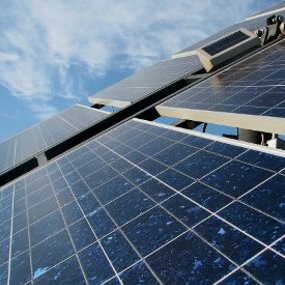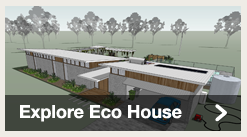Build it Back Greenbushfires
Standalone Solar
 Solar
photovoltaic systems are made from a series of panels that directly
convert energy in the form of light from the sun into electrical
energy. Solar power can be used in all parts of Australia as long
as you have a suitable site with a north-facing (or almost north
facing) roof, or ground space that is not shaded during the
day.
Solar
photovoltaic systems are made from a series of panels that directly
convert energy in the form of light from the sun into electrical
energy. Solar power can be used in all parts of Australia as long
as you have a suitable site with a north-facing (or almost north
facing) roof, or ground space that is not shaded during the
day.
With a stand alone system the energy produced by the solar panels is fed into a battery bank. The batteries are charged by the solar panels and the power for the home taken from the batteries when it is required.
An inverter that produces 240 volt AC (alternating current) is connected to the batteries to run standard mains powered appliances.
Many systems have more than one form of power generation, as energy from the sun cannot be relied on at all times. Other generator types include wind turbines and micro-hydro generators (less common). Back-up generators, usually petrol or diesel, are also usually included in stand alone hybrid systems.
How big a system you need and how much it costs is dependent on how much energy your house consumes. Probably the most important part of stand alone power system design that is often overlooked is the energy efficiency of a home. There is no point spending money on a solar system, wind turbines, batteries or a diesel generator when the energy it generates is wasted. Spending a few hundred or even a couple of thousand dollars on more efficient appliances and making your home more energy efficient means you can buy a smaller stand alone power system, at potentially significant long term savings.
There are no direct government rebates for installing a stand alone power system but they do qualify for RECs created through the Renewable Energy Target market. The amount of RECs your system qualifies for is dependant on its size and your location, and the costs associated with connecting to the grid.
If you are located more than one kilometre from the mains grid, or you have written proof from your electricity distributor that the cost to connect your property to the grid would be more than $30,000, you can get approximately 50% of the capital cost of your system back through the sale of your RECs (for solar systems up to 20kW in size, or for wind systems up to 10kW in size).
Warranties on the components of solar systems range from one to ten years for inverters; with the better quality panels offering 20 to 25 year guarantees.
As with all things, careful consideration of both price and quality should be undertaken to ensure your home's best option. Always get at least three suppliers to quote for the same size system so you are able to compare prices. Ask for details on the type and quality of solar panels and inverter. Also make sure that the installer has Clean Energy Council accreditation.
Suppliers
Energy Matters - www.energymatters.com.au
Ph. 1300 727 151
EnviroGroup - www.envirogroup.com.au
Ph. 03 9480 1905
K & C Stork - www.kcsolar.com.au
Ph. 03 5460 4224
Solar Charge - www.solarcharge.com.au
Ph. 03 9596 1974
Solar Shop Australia - www.solarshop.com.au
Ph. 13 376 527
Yarra Energy - www.yarraenergy.com.au
Ph. 0413 795 926
Listed suppliers are a guide and are not endorsed by Green Cross Australia or the Alternative Technology Association.


